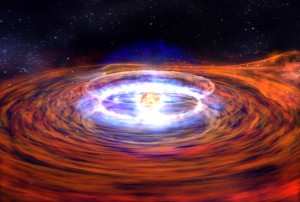Thermonuclear phases in neutron star detected by researchers
Saturday, March 3rd, 2012 6:12:31 by Taimoor Tariq
A team of researchers has been able to detect all phases of a thermonuclear process occurring in a neutron star that is located close to the centre galaxy of the Terzan 5 globular cluster. The observations were analysed by X-ray observation satellites.
This is the first time that scientists have successfully discovered all phases of the thermonuclear burning in a neutron star.
The star, located close to the center of the galaxy in the globular cluster Terzan 5, is a “model burster,” says Manuel Linares, a postdoc at MIT’s Kavli Institute for Astrophysics and Space Research.
Linares and his colleagues from MIT, McGill University, the University of Minnesota and the University of Amsterdam analyzed X-ray observations from NASA’s Rossi X-ray Timing Explorer (RXTE) satellite, and discovered the star is the first of its kind to
burst the way that models predict. What’s more, the discovery may help explain why such a model star has not been detected until now. A paper to be published in the March 20 issue of The Astrophysical Journal details the group’s findings.
Neutron stars typically arise from the collapse of massive stars. These stellar remnants are made almost entirely of neutrons, and are incredibly dense — about the mass of the sun, but squeezed into a sphere just a few miles wide. For the past three decades,
astrophysicists have studied neutron stars to understand how ultradense matter behaves.
In particular, researchers have focused on the extremely volatile surfaces of neutron stars. In a process called accretion, white-hot plasma pulled from a neighboring star rains down on the surface of a neutron star with incredible force — equivalent to
100 kilograms (220 pounds) of matter slamming into an area the size of a coin every second. As more plasma falls, it forms a layer of fuel on the neutron star’s surface that builds to a certain level, then explodes in a thermonuclear fusion reaction. This
explosion can be detected as X-rays in space: The bigger the explosion, the greater the X-ray intensity, which can be measured as a spike in satellite data.
Researchers have developed models to predict how a neutron star should burst, based on how much plasma the star is attracting to its surface. For example, as more and more plasma falls on a neutron star, explosions should occur more frequently, resulting
in more X-ray spikes. Models have predicted that at the highest mass-accretion rates, plasma falls at such a high rate that thermonuclear fusion is stable, and occurs continuously, without giant explosions.
However, in the last several decades, X-ray observations from nearly 100 exploding neutron stars have failed to validate these theoretical predictions.
“Since the late 1970s, we mostly saw bursts at low mass-accretion rates, and few or no bursts at all at high mass-accretion rates,” Linares says. “It should be happening, but for three decades, we didn’t see it. That’s the puzzle.”
Tags: Filthy, globular cluster Terzan 5, Lecherous, McGill University, neutron star, Rossi X Ray Timing Explorer, Storyline, University of Amsterdam, University of Minnesota
Short URL: https://www.newspakistan.pk/?p=14581

















